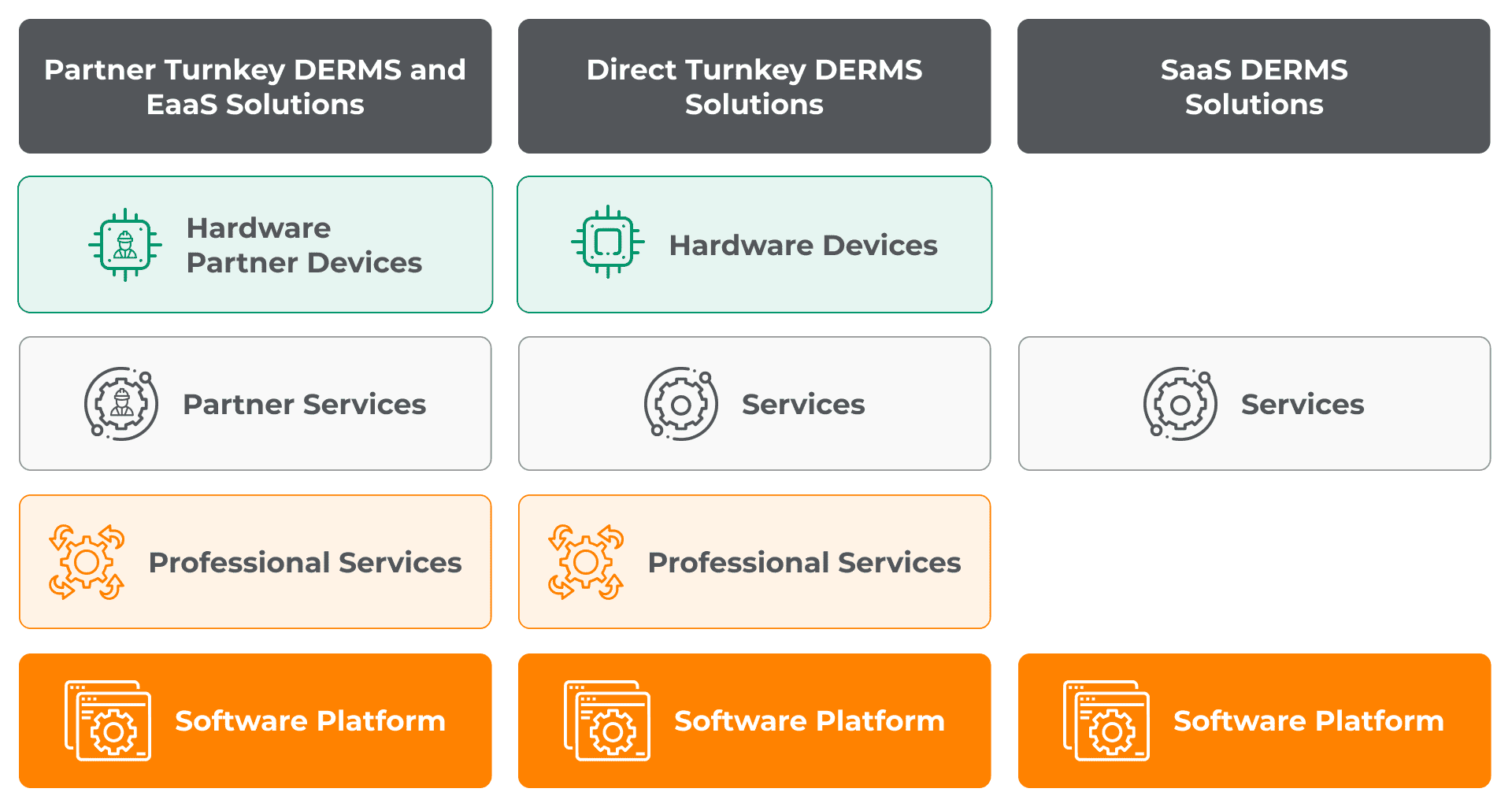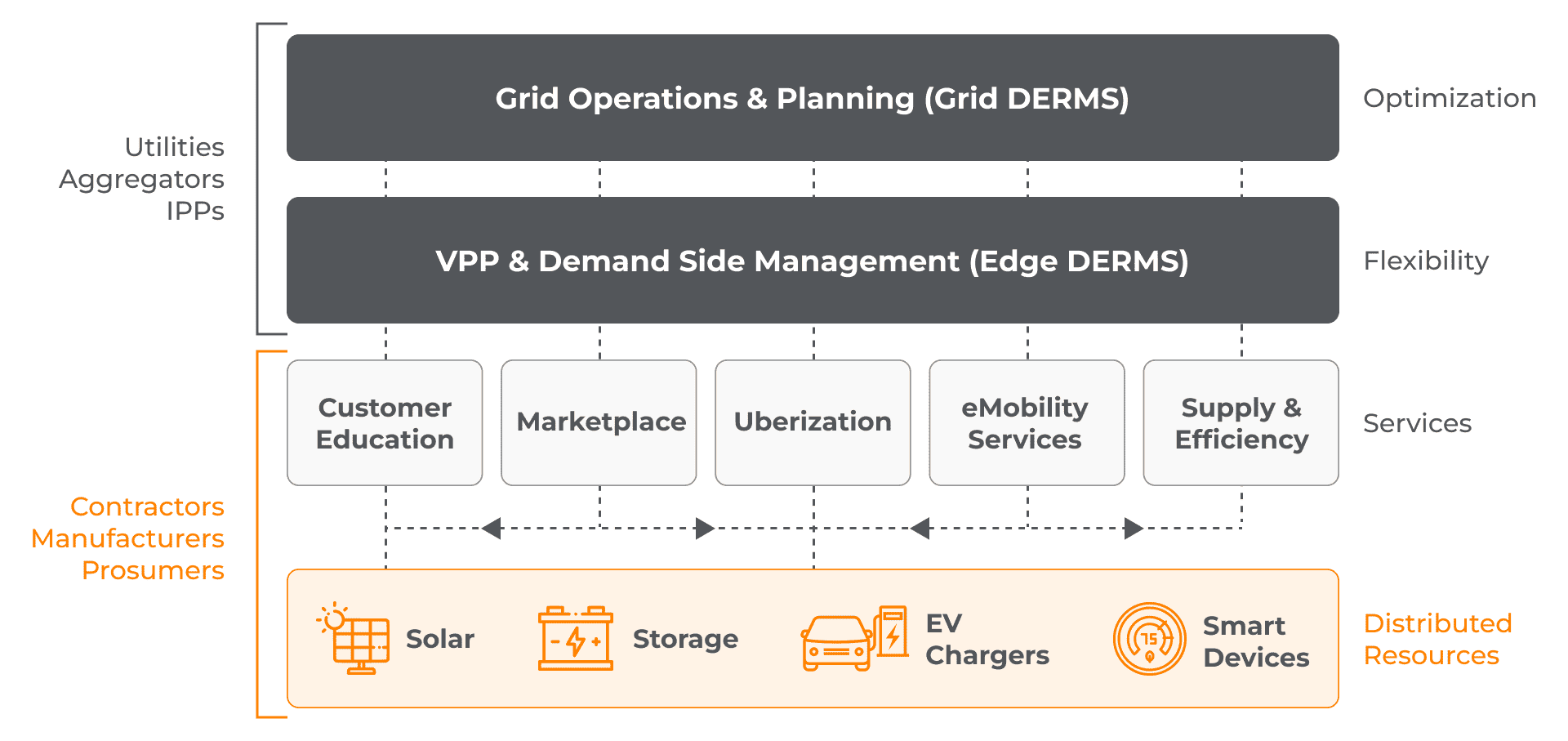Adopting a distributed energy resource management system (DERMS) is often mired with complexity. When is the right time to invest—and which DERMS solution (or group of solutions) should you choose? What are the risks if you move too early and lock in with a vendor whose platform is limited or incompatible with other vendors you’ve already contracted for assets or services? What if you wait too long, and customers lose out on reliability and cost savings?
The good news is that adopting a DERMS is not necessarily an all-or-nothing proposition. Utilities and grid operators can choose their own starting point and scale up over time as business objectives crystallize and markets further evolve to accommodate greater uptake of distributed energy resources (DERs) and renewable energy resources.
Whether you’ve deployed a DERMS solution in the past, or are considering a rollout for the first time, here are some critical factors to consider in order to capitalize on the latest technology and business model options.
Spanning Grid-to-Prosumer Needs with an End-to-End DERMS
What is a DERMS? Definitions vary across the industry, and the concept has continued to evolve over time. The latest thinking on DERMS is that it’s an umbrella for a wide range of platforms that manage, optimize, and extract value from DERs and larger grid assets. The most comprehensive version is the Grid-to-Prosumer DERMS model that supports both grid optimization and flexibility management, providing a unified view into energy supply and demand, DER deployments, and prosumer opt-in programs.
“Moving forward, an adaptable, end-to-end DERMS solution will likely become more attractive as DER adoption continues to grow and the need to reduce emissions from the power generation sector becomes more pressing.”
— Guidehouse, 2024 DERMS Leaderboard
No longer is a DERMS just serving a utility or a grid operator. A Grid-to-Prosumer DERMS also engages directly with large and small asset owners. It starts with upfront prosumer engagement and ends with measurement, verification, and payments for services performed. Along with sustainability and customer engagement initiatives, DERMS drivers may also include more fundamental tasks like planning for distribution system upgrades.
A Grid-to-Prosumer DERMS deployment can start with an advanced distribution management system (ADMS) or a demand response (DR) program. It can also be deployed on-premise or as a cloud-hosted solution. Wherever you begin, a stepwise approach to DERMS deployment provides a modular, flexible path to advance your utility’s goals. Before you decide where to begin, you’ll need to do some homework.

A Step-by-Step Approach for Mapping Your DERMS Deployment
Which DERMS solution is right for your utility or grid operator depends on a variety of different factors. Here are some key considerations for planning and getting started with your DERMS journey.
- Step 1: Assess Current Impact. Evaluate the existing impact of DERs on your system, including power quality, grid stability, and challenges associated with increasing DER penetration.
- Step 2: Build a DER Maturity Roadmap. Develop a roadmap aligning DER integration with your goals and regulatory requirements, considering your desired operational state and regional mandates.
- Step 3: Analyze Customer Behavior. Understand your customer behaviors and needs, especially those with behind-the-meter DER installations, by analyzing interconnection requests, DER adoption trends, and DR program participation.
- Step 4: Conduct a DER Penetration Assessment. Analyze the level and types of DERs in your service territory, such as smart thermostats and water heaters, solar PV, battery storage, and electric vehicles.
- Step 5: Scope Regulatory Requirements. Explore the latest regulatory requirements so you can stay informed about evolving compliance issues and potential government incentives to help guide your DERMS rollout sequence and strategy.
- Step 6: Data Management and Security. Establish robust data management and cybersecurity measures to collect, store, and protect DERs data while ensuring compatibility with various devices. You can then vet potential DERMS partners to verify they can support your security and data requirements.
Selecting a Grid-to-Prosumer DERMS: Choices and More Choices
Choices are great if you have the right information to evaluate the pros and cons. For example, software-as-a-service (SaaS) has been the mainstay business model for DERMS applications because until recently, end-to-end solutions didn’t exist. SaaS deployments still dominate flexibility markets. This deployment model makes sense for utilities that still want to play a major role in DR recruitment and program management.
Within the last few years, turnkey offerings that provide an end-to-end solution for utilities have come to the forefront. These solutions are still customized to the specific needs of a utility or grid operation, but are managed by a third party that delivers megawatts instead of software. Choice continues to permeate decision-making, as there are then there are somewhat subtle distinctions between direct turnkey offerings from a single entity versus partner-network turnkey offerings.
Then there’s some optionality between on-premise or cloud architecture for a Grid-to-Prosumer DERMS. On-premise solutions, which followed in the footsteps of ADMS deployments, have been the traditional deployment choice due to cybersecurity concerns. However, with today’s rigorous cloud security and privacy standards, utilities are increasingly moving toward hybrid on-premise / cloud or fully cloud-based solutions. As markets evolve, cloud solutions become even more attractive, since they support greater scale and flexibility compared to on-premise solutions.

Under One Roof: A Grid-to-Prosumer DERMS Solution
There are many variations of DERMS, but perhaps the best example of the evolution of this concept is Schneider Electric’s Grid-to-Prosumer DERMS. This end-to-end solution revolves around open standards, flexible adoption pathways, and creative business models. It has the potential to transform DERMS from a puzzling question into a clear-cut solution to a host of grid optimization and flexibility management challenges that will only grow over time.

Schneider Electric’s Grid-to-Prosumer DERMS platform brings together emerging solutions for grid optimization, flexibility management, and prosumer engagement that support today’s energy transition.
- On one side is Schneider Electric’s EcoStruxure DERMS, a grid optimization solution that can be deployed as a standalone on-premise solution, integrated with an ADMS, or hosted in the cloud.
- On the other side of the utility meter is AutoGrid Flex, built on a cloud-native architecture that leverages AI to fill in gaps in supply and demand in real-time using DERs. Both SaaS and turnkey solutions are available, with the latter allowing utilities to buy capacity from DERs as they used to buy capacity from traditional power plants.
- At the customer engagement end of the spectrum is Uplight’s prosumer engagement platform, which helps utilities reduce their baseload with consumer programs that drive energy efficiency while adjusting to real-time grid conditions.
In Summary
As electricity loads continue to increase due to decarbonization initiatives and the DER landscape becomes more and more complex, utilities and grid operators need AI technology more than ever to protect grid stability while still delivering bidirectional value. Whether you start from the grid optimization side with an ADMS and expand to flexibility management and prosumer engagement, or already have active DR programs and want to connect them to front-of-the-meter operations and assets, investing in a Grid-to-Prosumer DERMS can pay huge dividends for you and your customers.
With a solid overview of your options informing a strategic step-by-step approach to deployment, you can first evaluate and then find the right DERMS model to support your operational needs and leverage your customers’ assets. Some DERMS business models require no upfront capital costs for resiliency services from microgrids while others allow you to directly purchase clean power capacity. Powered by scalable solutions, you’ll be able to optimize your grid, leverage the growing ecosystem of abundant and diverse DERs, and engage directly with customers—which is great for your business and the planet.





